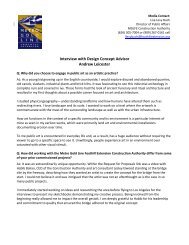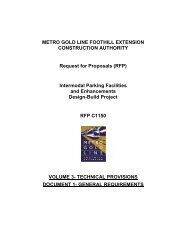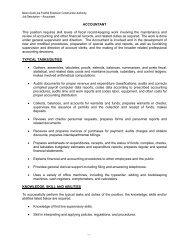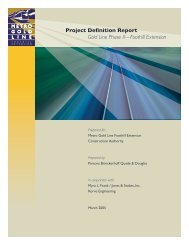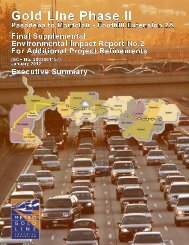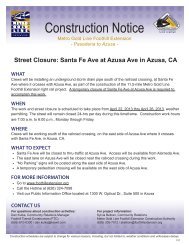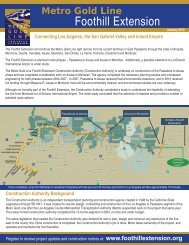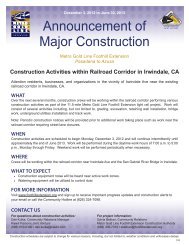Part 3 - Metro Gold Line Foothill Extension
Part 3 - Metro Gold Line Foothill Extension
Part 3 - Metro Gold Line Foothill Extension
Create successful ePaper yourself
Turn your PDF publications into a flip-book with our unique Google optimized e-Paper software.
Noise and Vibration Technical Report: <strong>Metro</strong> <strong>Gold</strong> <strong>Line</strong> <strong>Foothill</strong> <strong>Extension</strong>, Azusa to Montclair<br />
July 2012<br />
Page 88<br />
6.3 Construction Noise<br />
Without noise mitigation, construction of the project is expected to generate noise levels that exceed any<br />
thresholds imposed by the Construction Authority in areas near residences. Measures to reduce<br />
construction noise levels include:<br />
• Noise Control Plan: The contractor should be required to develop a Noise Control Plan that<br />
demonstrates how he will achieve the appropriate noise limits. The plan should include<br />
measurements of existing noise, a list of the major pieces of construction equipment that will be<br />
used, and predictions of the noise levels at the closest sensitive receivers (including residences,<br />
hotels, schools, churches, temples, and similar facilities). The noise control plan should be<br />
approved by the <strong>Metro</strong> <strong>Gold</strong> <strong>Line</strong> <strong>Foothill</strong> <strong>Extension</strong> Construction Authority prior to initiating<br />
construction.<br />
• Alternative Construction Procedures: Where the construction cannot be performed in accordance<br />
with the requirement of the noise limits, the contractor should be required to investigate<br />
alternative construction measures that would result in lower sound levels. Also, the contractor<br />
should be required to conduct noise monitoring to demonstrate compliance with contract noise<br />
limits.<br />
• Best Management Practices: The contractor should be required to use the following best<br />
management practices for noise abatement wherever practical:<br />
- Use specialty equipment with enclosed engines and/or high performance mufflers when<br />
feasible. The contractor shall locate equipment and staging areas as far from noise<br />
sensitive receivers as possible.<br />
- Limit unnecessary idling of equipment.<br />
- Install temporary noise barriers as needed and where feasible.<br />
- Reroute construction related truck traffic away from residential streets to the extent<br />
permitted by the relevant municipality.<br />
- Avoid impact pile driving where possible. Where geological conditions permit, use<br />
quieter alternatives such as drilled piles or a vibratory pile driver.<br />
Specific measures to be employed to mitigate construction noise impacts would be developed by the<br />
contractor. In addition, the Construction Authority should be available during construction to discuss and<br />
address noise complaints from residents and business owners.<br />
6.4 Construction Vibration<br />
It is unlikely that vibration from construction activities will exceed the thresholds for minor cosmetic<br />
damage to buildings. In the event that equipment producing high levels of vibration may approach those<br />
limits, the noise control plan should also include measures to minimize vibration impacts during<br />
construction. Also, representatives from the Construction Authority should be available to discuss



